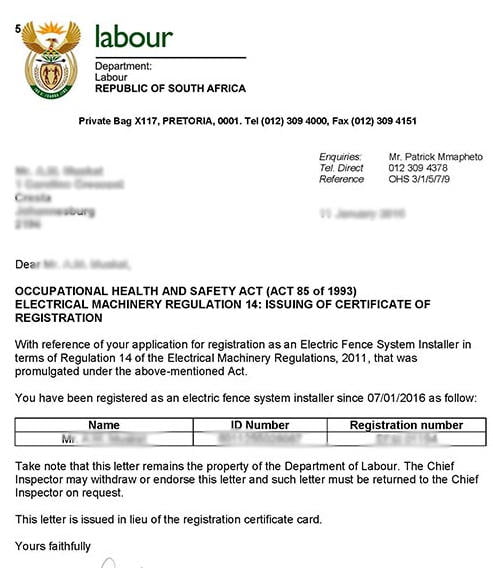Electric fence compliance certifcate
What is the purpose of this Act?
A law was promulgated to ensure the safety of citizens of South Africa with regard to all electrical systems and appliances.
- The purpose of this section of the Electrical Machinery Regulations, 2011 is to protect the general public from getting inadvertent shocks from poorly installed or erected electric fences.
- The second objective of this section of the regulations is to prevent radio interference caused by non-compliant energizers, unsound earthing, and other unacceptable installation practices.
- Thirdly, the Act aims to protect the consumer by specifying minimum fencing material quality standards.
Who receives a Certificate of Compliance
- In the case of a new installation or upgrade, the person requesting the work or their designee.
- An original Electric Fence System Certificate of Compliance is provided to the buyer of a property, and copies are provided to the seller and the attorney/conveyancer responsible for the transfer of ownership.
- It is not necessary to send a copy to any government department.

To download copy of Electrical Machinery Regulations, 2011 – Click Here
Who can Certify
When to issue
When is it not required
Which standards apply
Sectional Title
Who can Certify
Only a Registered Electric Fence Installer (by the Department of Labour), in terms of the legislation, can register an electric fence installer. The chief inspector will issue a certificate of registration to the electric fence installer and enter it into the national database.
The Electric Fence System Certificate of Compliance is filled in by the registered individual, who assumes full responsibility for the installation or supplementary work.
When to issue
A compliance certificate is required for any new installation. It is the end result of the installation process.
An electric fence must adhere to all safety requirements, comply fully with all relevant legislation, and be operational according to its specifications.
The COC compliance certificate or supplementary certificate is also required when a change or addition is made to an existing installation. These can be detailed as follows:
• Replacing the old energizer with a new one.
• Additions to the electric fencing, such as extending the electric fencing.
• Major repairs to the electric fencing, such as a section of electric fencing that has to be replaced. (i.e. brackets and wires)
• Any other change to the electric fencing, that will affect the installation in terms of the requirements contained in SANS 10222-3.
When is it not required
A certificate is not required, provided the remainder of the electric fencing remains intact, when:
• Repairing a broken wire
• Replacing a broken bobbin
• Repairing the energizer
• Replacing a lightning arrestor
• Other repairs of a minor issue, that do not affect the installation in terms of the requirements contained in SANS 10222-3
Which standards apply
The prevailing legislation (SANS 10222-3) and latest published standards apply at the time of issuing a certificate. The legislation and published standards apply at the time of the first time a certificate is issued. (Current standards cannot be applied to old installations when a different set of standards were published.)
Sectional Title
Electric fences installed around the perimeter of a sectional title scheme are normally done by the body corporate. The body corporate is an entity with its own rights and assumes the responsibility for the installed electric fence on the perimeter and any other common property.
The owners of units within the scheme do not require an Electric Fence System Certificate of Compliance for the perimeter electric fence. But should owners of units within the scheme erect and/or maintain their own electric fences, an Electric Fence System Certificate of Compliance would be required.
Recent Posts
Request A Quote Today
...
